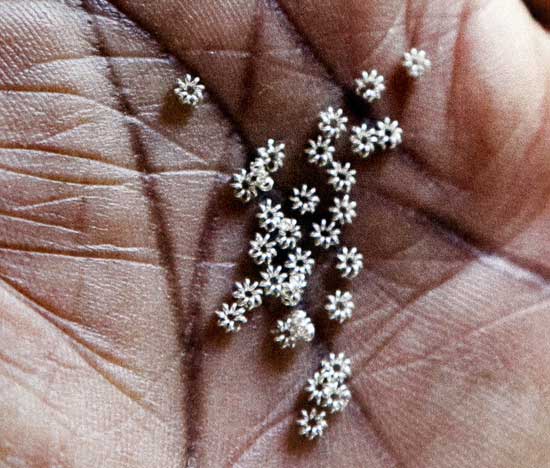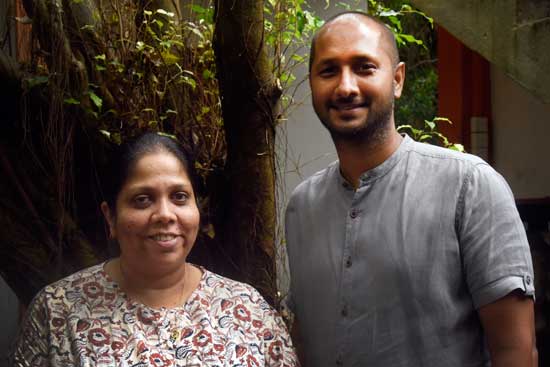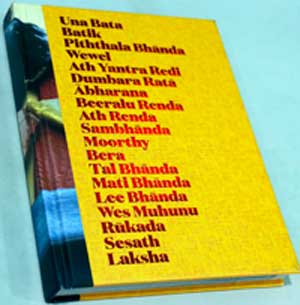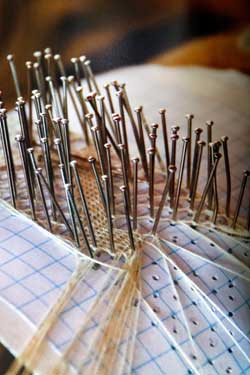Crafted with love
It is a volume born of long and assiduous hours spent in small workshops, batik sheds, smithies, mills, wadu maduwas and sacred artisanal spaces. ‘Capturing the Handicrafts of Sri Lanka’ is a pictorial record of the crafts of our island culture, some of them now threatened with extinction.
For the authors Inoka Dias and Mahesh Wanigasooriya, it all began in 2018, when Inoka, a bit jaded with her wildlife photography, thought she might as well turn to a less explored milieu, our traditional handicrafts.

Images from the book: Delicate jewellery and below, the book and the beeralu process
Mahesh, who sat next to her at the corporate office where they both worked, was taken on board and they mapped a project, today a book as artisanal as the crafts they pay homage to.
For five years the unlikely friends (Inoka the literary one – serious and enthusiastic and Mahesh more happy-go-lucky) traversed the island from Jaffna to Dondra on weekends mostly with sandwiches packed for the road – travels that usually began at three in the morning and ended late night happily-tired.
Eighteen crafts are recorded in the book (the photos by Inoka and Mahesh, and text by Inoka) a pictorial journey not just into the artistry, detail and technique but also the lives of the guardians of these crafts.
These villagers however poverty-stricken opened their hearts and homes to the authors with the offer of a cuppa at least, more often more.

From friends to co-authors: Inoka Dias and Mahesh Wanigasooriya. Pic by Akila Jayawardena
Their travels began in Weligama, the quaint home of beeralu renda or Bobbin lace in the south, as elegant as the sea foam, and then they went to Marawila where ath renda or crochet, a practice Inoka’s own mother was partial to, is used to create delicate lacy cushions, saree jackets and furnishings.
Talking about masks and puppets of Ambalangoda, Inoka muses about a fire-lit night-time kolam performance at Ambalangoda, with the masks “mesmerizing, hilarious, frightening, regal… depending on… scenes.”
 A big spread is naturally given to abharana – jewellery, given the intricacy involved. It was an ancient tradition and the artist creating royal regalia was considered ‘as the one performing the highest service to the land’.
A big spread is naturally given to abharana – jewellery, given the intricacy involved. It was an ancient tradition and the artist creating royal regalia was considered ‘as the one performing the highest service to the land’.
The thal bhanda (palmyra-leaf crafts) artisan Elangeswari from Jaffna is one gentle soul they met – camera-shy, never looking them in the eye. Drawing a wholehearted smile from her lighting up her face, was, for Inoka, a treat.
While most crafts are indeed on the brink of dying, with the new generations intent on finding at least a ‘garment-job’ or ideally looking to go abroad, they note that there were some glimmers of hope in Dumbara and Molagoda, where the communities respectively of mat-weaving and clay pottery have the youth actually studying the crafts professionally at vocational centres.
One of the most beautiful crafts and also probably the most endangered, says Inoka, is laksha or lacquer work. Originally made using the resin produced by a beetle with a 21-day lifespan, found in areas like Lakgala, Wilgamuwa and Hettipola, the resin now has to be imported from Karnataka, that insect now being extinct.
The artist uses his fingernails to form the patterns on laksha, and while today we think only of lacquer boxes, laksha adorned also bows and arrows, walking sticks, flag-staves, spears and shafts.
 Sometimes the pair would visit a village only to find the craftsman busy with a shramadana or with the ceremony of their grandson’s first letter reading. And they would participate themselves.
Sometimes the pair would visit a village only to find the craftsman busy with a shramadana or with the ceremony of their grandson’s first letter reading. And they would participate themselves.
The most fascinating objects were the bera or traditional drums. While the northern drum is made with jak wood and goat’s skin for leather, the upcountry drum demands monkey or monitor lizard skin on the right side and cattle or goat skin on the left.
Memorable for Inoka was her visit (in train, then bus) to Maruthamunai, to discover ath-yanthra redi or handloom textiles. The family of craftsman Najith in that town have been producing the famous Maruthamunai sarongs and sarees since the 1930s. Here too however, the atmosphere now is elegiac because the industry has taken severe thrashings – the tsunami, the Easter Sunday attacks, COVID and the economic crisis.
Compiling of the book was no easy task, say Inoka and Mahesh. But, fired by their gratitude to the artisans who cooperated with warmth and generosity and by their dream to showcase Lanka’s resplendent heritage “of art forged with material sourced from nature, and distinctive designs shaped by the four elements of earth, fire, water and wind”… pull through they indeed have!
Printed in Singapore, this book is designed and compiled with much care, the detail of the crafts beautifully captured in the photographs.
Capturing the Handicrafts of Sri Lanka will be available from October 26 at Barefoot and selected Sarasavi outlets; or contact handicraftsofsrilanka@gmail.com.
Searching for an ideal partner? Find your soul mate on Hitad.lk, Sri Lanka's favourite marriage proposals page. With Hitad.lk matrimonial advertisements you have access to thousands of ads from potential suitors who are looking for someone just like you.


